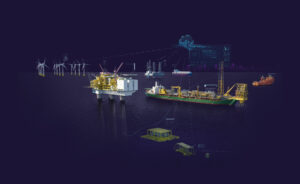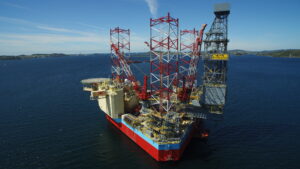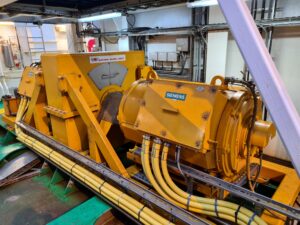‘Green’ innovations flourish amid drive for lower emissions
Peak shaving, energy storage systems already reducing offshore diesel use, while mobile wind units, fuel cells emerge as part of the next wave
By Stephen Whitfield, Associate Editor

Maersk Intrepid jackups. BlueDrive is being installed on two Odfjell Drilling semisubmersibles, with additional installations being considered. Siemens is now also helping to develop mobile offshore wind units that could serve as portable energy systems for offshore rigs.
The offshore drilling industry has long recognized the importance of environmental protection and the need to operate sustainably, but in recent years, it’s also come to prioritize decarbonization. As key players in the global transition to a net-zero economy, operators, contractors and service companies are all investing more and more in innovative technologies that can reduce greenhouse gas emissions from drilling operations, from hybrid rigs to floating wind turbines to the use of shore power.
A growing number of companies are also publicly cementing their commitment to the low-carbon transition by announcing significant emissions reduction targets. For instance, Maersk Drilling announced last September its goal to reach 50% reduction in the intensity of CO2 emissions from its drilling operations by 2030.
2020 also saw Siemens Energy launch its sustainability program, a key element of which is for the company to become climate-neutral by 2030. This means eliminating all Scope 1 (direct emissions from owned or controlled sources) and Scope 2 (indirect emissions from the generation of electricity) emissions. In the same timeframe, the company aims to cut Scope 3 emissions (all other indirect emissions) for its Gas and Power segment by 27.5% over 2019 levels.
“What you’re seeing right now are some aggressive goals, but that’s what is needed,” said Stig Olav Settemsdal, Global Head of Technology, Offshore Solutions at Siemens Energy. “We need to create this new sustainable future. It will require us to develop a future energy mix.”
To meet aggressive emissions targets, innovation and new technology R&D will be critical. When looking at certain hurdles – like being able to eliminate the use of diesel generators on the drilling rig – there are still no optimal solutions yet, said Caroline Alting, Head of Integrity and Projects at Maersk Drilling. At the same time, she said, the other half of the battle will be figuring out how to use existing systems and technologies to generate additional efficiencies.
“If you look at our 50% reduction target, probably half of that reduction is going to come from known energy-reducing technologies like energy storage systems and extended intelligent use of online data, which can also help identify the systems which hold the greatest optimization potentials,” she said. “Of course, there will always be limitations, but the technologies are there. We just need to find a way to use them right.”
Batteries and wind power
One of Siemens Energy’s newest technologies for reducing emissions offshore focuses on transforming how energy is distributed on a drilling rig. The BlueDrive DC Grid system consists of DC/DC converters connected to existing drilling drive DC buses – heavy conductors that distribute direct current – and to energy storage systems via additional DC/DC converters. This setup allows users to level out peaks in energy demand – a process known as peak shaving – during drilling operations. This allows fewer generator sets to run at higher and steadier loads, reducing fuel consumption on the rig.
“You could go from having six engines running to having four engines running, but still, you’re not allowed to operate those four engines at more than 66% power because if you lost one of those engines, the remaining three would have to be able to take over the energy from this one. But if you install battery energy storage systems in such a system, you can run the engines up to 90% or 100%,” Mr Settemsdal said.
In January, the company announced a deal to install the BlueDrive DC-grid system on a pair of Odfjell Drilling semisubmersibles, the Deepsea Atlantic and Deepsea Nordkapp. Additional installations are being considered for the Deepsea Stavanger, Deepsea Aberdeen and Deepsea Yantai. The technology is expected to play an integral role in Odfjell’s push for zero-emission drilling.
“These projects are the result of asking a simple yet challenging question: ‘What would be the most efficient technological approach to minimize emissions from a rig in the short term?’” said Per Lund, Chief Technology Officer and Executive Vice President at Odfjell.
Another carbon-reduction innovation for offshore drilling revolves around Siemens Energy’s BlueVault lithium-ion energy storage system. The technology, launched in 2019, connects to the power grid on a rig and works in tandem with the rig’s existing generator sets. Much like the BlueDrive system, BlueVault is designed to reduce the need for additional generators on the rig. However, while the former levels out peak demand, the latter feeds energy into the grid during peak hours.
Each BlueVault system has one battery that consists of nine modules, each with 28 battery cells. An optimal battery installation can potentially produce as much energy as a diesel engine running at 90-100% power, although it is typically designed to operate only for 30 minutes at a time before it needs to be recharged from the rig’s diesel generators.
The system was first installed on Seadrill’s West Mira semisubmersible in late 2018. According to Siemens Energy, this has resulted in approximate reductions of 42% in the runtime of on-platform diesel engines, 12% in fuel consumption, 15% in CO2 emissions and 12% in NOx emissions. More recently, Maersk Drilling installed the BlueVault on a pair of jackups, the Maersk Integrator and Maersk Intrepid.
Beyond these energy distribution and battery storage systems, Siemens Energy is also looking to renewable energy as a means to help offshore rig owners reduce their need for diesel power. On 18 June, the company announced a partnership with Odfjell Oceanwind, a floating offshore wind technology company that was acquired by Odfjell Drilling in August 2020.
The partnership will focus on configuring a fleet of mobile offshore wind units (MOWUs) to power drilling rigs. These semisubmersible MOWUs will encompass Siemens Gamesa wind turbines and Odfjell Oceanwind’s WindGrid floating wind power system. The latter is still under development and will serve as the power system when installed on the wind turbines.
While the turbines have power capacities up to 14 MW, they are highly dependent on natural and fluctuating wind speeds. WindGrid will help mitigate the intermittency problems often found with wind power by adding a battery energy storage and grid converters to create a microgrid in each MOWU. The decentralized group of energy sources would act as a self-sufficient energy system to provide uninterrupted power to the rig, with battery energy storage serving as a backup for times when wind power is insufficient.
On 21 June, DNV announced that it had completed a concept verification of WindGrid, confirming its technical feasibility and a 60-70% range for expected CO2 emissions reductions in the North Sea compared with generating electricity from conventional
gas turbines.
Siemens Energy’s goal, Mr Settemsdal said, is to support Odfjell Oceanwind with the MOWU development to enable a renewable system that can ultimately become the primary power source on a floating rig, relegating the diesel generator to a backup system. The project aims to have MOWUs available for commercial use by 2024.
“When you have a moveable drilling rig, you need to be able to move the power generation with you,” he explained. “Four or five moveable offshore wind units can be connected to a large drilling rig and cover all load demand, then you can design new drilling rigs with fewer diesel engines installed as you only need them during transit between locations and for the days when there’s no wind, which doesn’t happen very often in the North Sea.”
While this MOWU project is initially focused on the North Sea, where wind energy is plentiful, Mr Settemsdal said the technology could theoretically be deployed anywhere in the world. In addition, because of their portability, the MOWUs could be used as electrical fuel stations for a variety of marine operations to drive sustainability.
Multi-pronged efforts leading to tangible results for Maersk Drilling
At Maersk Drilling, in addition to the BlueVault energy storage system installed on the Maersk Integrator and Maersk Intrepid jackups, the company has also developed two other ESG-enhancing technologies. One is the cloud-based Energy Emissions Efficiency software. In combination with high-accuracy fuel flow meters on each engine, it uses real-time data to monitor energy use onboard the rig.

The software monitors fuel and energy consumption and consequently greenhouse gas emissions, providing insight into when energy was consumed, what equipment consumed the energy and how efficiently the energy was generated.
The other technology is a selective catalytic reduction (SCR) system, where urea is injected into the exhaust stream of a diesel engine. The urea sets off a chemical reaction in the catalyst elements that converts the harmful NOx emissions into harmless nitrogen and water.
Last November, the Maersk Intrepid became the first rig to operate with all of these upgrades when it began drilling for Equinor at the Martin Linge field in the North Sea.
The BlueVault energy storage system was fitted into two custom-designed and -built containers that were placed on the pipe rack deck. According to Maersk Drilling, the installation required extensive electrical and structural work, including modifications and interfaces to several auxiliary systems on the cantilever, as well as integration and updates to the power management systems onboard.

The SCR equipment was installed in close proximity to existing exhaust pipes following major structural and piping modifications, as well as the installation of urea tanks to enable injection.
In its first month of operations following the upgrades, the Maersk Intrepid saw a 25% reduction in CO2 emissions compared with the rig’s baseline average. In addition, NOx emissions went down by approximately 95%, which exceeds the original reduction target of 90%.
The Maersk Integrator completed its low-emissions upgrades in March 2021 and has since worked for two operators in the Norwegian North Sea – for Aker BP at the Tambar field and then for OMV on Production License 970, near the Oselvar field. The rig is scheduled to return to work for Aker BP in September, with a two-well campaign at the Ivar Aasen field.
The Energy Emissions Efficiency system and its sister system, Energy Efficiency Insight, have proven particularly helpful in providing Maersk Drilling with a clearer understanding of where its fuel consumption is coming from and how accurately its fuel use measurements are, Ms Alting said.
Each rig is equipped with high-accuracy fuel flow meters and sensors that are connected to the control and monitoring systems, which are then connected to offshore servers that collect and send energy usage data to an onshore remote operations center. The data is also transmitted to Maersk’s cloud computing database, where it can be modeled. Sensor data related to energy consumption can be used to visualize how fuel is consumed on the rig. This helps rig crews identify where they can improve energy efficiency. For instance, crews have already become more comfortable performing various operations on the rig without running a backup generator set.
“With monitoring systems utilizing the sensors and meters we already have on the rig, we are now able to make deep dives into the energy consumption onboard and both identify and visualize optimization potentials,” Ms Alting said. “With the high accuracy of the systems, it has a huge impact on your behavior because you can make a lot of consumption patterns transparent to the crew and the operations department. That drives a lot of reduced consumption.”
She noted that the company is also looking into the viability of outfitting more rigs with the capability to use shore power. In 2017, the Maersk Invincible became the industry’s first harsh-environment jackup to operate entirely on electricity generated from shore, when it began a five-year contract with Aker BP at the Valhall field in the North Sea. The rig’s power grid was connected to a high-voltage power supply located in Lista, a municipality in southern Norway, that is capable of supplying up to 10 MW of power to the rig. Over the life of the five-year contract, Aker BP expects to save 28,285 tonnes of diesel, 89,602 tonnes of CO2 and 1.3 million kg of NOx.
As of July, the Maersk Invincible is still the only rig with shore-power capabilities in Maersk Drilling’s fleet. The technical modifications required to use shore power vary depending on the available shore-power supply. They can involve adaptation of both voltage and frequency to match the power system of the rig by retrofitting converters and transformers onboard.
While Maersk Drilling has a firm understanding of the technical scope for converting more rigs to shore power, Ms Alting said the main challenge in doing so is the demand from operators.
Reducing emissions by using shore power can only be realized if a rig is connected to a power grid that’s mostly powered by renewable energy. This works well in Norway because the country’s energy grid is primarily hydropower, so running a rig on that grid would provide significant emissions reductions. In fact, the Maersk Invincible has seen a nearly 100% reduction in greenhouse gas emissions since it started operating on shore power on the Valhall field.
However, in places where that type of energy grid infrastructure is not in place, operators may not be willing to award contracts for shore power.
“It’s very much dependent on customer engagement,” Ms Alting said. “The oil majors of the world need to commit to actually bringing this power to their fields, and the infrastructure from the countries that actually want to enable this is also important.
Norway is far ahead on this. They have great infrastructure, and they have operators who are really committed to bringing shore power out to their fields.”
More recently, Maersk Drilling has also looked to fuel cells to generate power for the rig. On 19 April, the company announced its participation in a new project to develop a high-temperature polymetric electrolyte membrane (HTPEM) fuel cell system that can be used on marine vessels, such as a floating rig.
Fuel cells, which have typically been used to power electric cars, take low-emissions energy sources like hydrogen and methanol and convert them into electrical energy through a chemical reaction. These systems often come with a battery backup, and they do not require access to a power grid. Compared with most types of fuel cells, PEM fuel cells have a higher tolerance for thermal cycling, the process of cycling through temperature extremes at high rates of change. This makes them better suited for the variable power production needed from a generator.
Unlike conventional PEMs, which employ water-containing polymers such as electrolytes to generate the chemical reactions that power them, HTPEMs utilize polymers covered in phosphoric acid membranes. This allows them to operate at temperatures as high as 200°C (392°F), while conventional PEMs cannot be used at temperatures above 80°C (176°F). The high-temperature capability provides better tolerance to fuel impurities, as well as faster chemical reactions, which makes them a promising technology for offshore installations because they often require significant power generation in short periods of time.
Most fuel cells utilize hydrogen as the primary fuel source because hydrogen emits water as a by-product. However, the system being developed under the Maersk Drilling-involved project will use methanol as fuel. Methanol, which is produced from hydrogen and carbon dioxide, has a higher energy density than hydrogen, thus it requires less storage capacity in an offshore installation compared with hydrogen. Additionally, it can be handled as a liquid fuel.
To ensure the methanol is “green,” it is important that the main constituents are obtained from a renewable feedstock, like captured CO2, a biomass or a geothermal borehole, instead of using typical petroleum-based feedstock. This will help to ensure the fuel cell is a carbon-neutral source.
Trials to examine the system’s durability are expected to start later this year. To be feasible for use on a rig, the system will need to run for a lifespan comparable to that of combustion technologies while still generating enough power. A 2016 study by the Institute of Climate Research tested a methanol fuel cell system with a proven 20,000-hour lifetime, but that system only generated 1.3 kW of energy, much less than the 2-3 MW that can be obtained from the typical diesel generator set used onboard a hybrid jackup.
The fuel cell test setup will start with a 200-kW capacity, but the companies plan to test the system at incrementally higher power levels, with the goal of reaching 5 MW, through a modular approach. Maersk Drilling and its partners on the project – fuel cell technology producer Blue World Technologies, shipping vessel owners DFDS and Hafnia Tankers, and Alfa Laval, a developer of heat transfer, centrifugal separation and fluid handling technologies – hope to have a system that can match the power of diesel generators by 2023.
“Right now, we’re still missing that game changer,” Ms Alting said. “Energy storage and batteries can do some of the work, but that’s still relying on generators. What can you do to take the gen sets out? What would provide us enough power to generate 5 MW? We’re looking for that replacement that can deliver the same amount of power, be green and not emit. That’s the challenge.”
Beyond its core rig operations, Maersk Drilling is also collaborating with other industry stakeholders to seek additional ways of enhancing ESG performance. For example, the company is contributing its drilling expertise to Project Greensand, a consortium with INEOS Oil & Gas Denmark and Wintershall Dea that is looking to develop 4-8 million tonnes/year of capacity for carbon capture and storage before 2030. That figure would represent more than 20% of Denmark’s carbon reduction target.
In November 2020, the consortium received a certification of feasibility by DNV for the storage of up to 450,000 tonnes/year of CO2 per well over a 10-year period. The companies hope to have the first well ready for injection from the field by 2025.
Adapting technology used by F1 and NASA
NOV is taking a unique approach to enabling carbon reductions, with the recent launch of a system that takes advantage of the energy generated by the rig’s motion to minimize generator usage during times of peak energy demand. The PowerBlade kinetic energy recovery system (KERS) aims to alleviate the heavy burden that heave compensation and tripping operations often place on an offshore rig’s energy supply.

The system captures regenerated electrical energy when the drawworks, crane or winch slows and stops the load on the hook. Previously, this energy was dissipated as heat using braking resistors attached to a rig’s motor control system. It utilizes a rotating mechanical device that accelerates and gathers speed as the drawworks are in motion.
That rotating device – also called a flywheel – generates kinetic energy, which is stored within the system, converted into electricity and fed back into the power grid. It compensates for the heave motion of the vessel as needed without calling for additional energy from a diesel generator. The flywheel can absorb up to 1.75 MW of power at its peak and distribute the same amount of power over a period of 6-10 seconds, the typical length of time for an active heave motion. However, operations with longer energy demands, such as a tripping operation, can cause a wide variation in energy consumption over large power peaks.
To handle these situations, NOV installed a 450 kWh lithium-ion battery system that can be charged by the engine or by the flywheel. The combination of the flywheel and the battery system can lead to noticeable energy savings, NOV believes. In fact, the company estimates that a single generator running on a high load consumes 14% less energy than two generators producing an equivalent total power at a light load.
“You want your drilling rig to be a steady consumer. If you have peaks up and down, it’s very difficult to size the inflow of energy to your rig. That’s why the generators of today work fine, because you can just ramp up the generator when you need that additional power,” said Andreas Karlsen, Project Sales Manager at NOV. “But when you’re looking to reduce your fuel consumption, if you’re running your rig on, for example, three generators, the goal should be to reduce it to two. The flywheel takes away the tops, so you’re stabilizing the energy needed to run your drilling operation.”
NOV adapted the PowerBlade technology from a previous flywheel-based system that it had developed in 2014 for a well intervention vessel, although that project was shelved during the downturn. Reviving the idea in 2018, NOV worked with Odfjell Drilling to run computer simulations of the technology using real-time operating data from the Deepsea Atlantic semisubmersible.
Various modes were simulated: an active heave compensation mode, in which the system prioritizes feeding kinetic energy from the flywheel while the drawworks are in motion; power boost at tripping, where the battery system provides additional power to support high-demand tripping operations; and operations during a blackout period. NOV then tested a prototype of the PowerBlade system at its Kristiansand, Norway, facility.
While kinetic energy recovery systems are not a new technology – it has been used on Formula 1 racing vehicles and NASA exploration spacecraft for years – scaling it for offshore use was a challenge. While a flywheel in a car typically weighs 18-20 lbs, the flywheel for the PowerBlade system weighs approximately 15 tonnes. “When you have a heavy rig going up and down in the water, you’re going to generate a lot of energy,” Mr Karlsen said. “We had to resize the flywheel disc and the motor so that it could generate energy and spool energy back into the system. It needs to work as a two-way motor.”
Finding space for the system near a rig’s power grid can also be a challenge, as the equipment measures 5.5 m in length, 1.75 m in width and 1.5 m in height. There are currently no design mechanisms that allow for a reduction in size, so rig owners must find enough space near their rig’s power grid to install the system.
In June, the Deepsea Atlantic became the first rig to use the PowerBlade system. Based on data from the first month of operation, Odfjell is expecting a 25% reduction in daily fuel consumption over the next year, from 30,000 liters/day of fuel prior to installation to around 22,000 liters/day. Based on an estimate of 3.23 kg of CO2 eliminated for every liter of fuel saved, that would result in a 17-tonne reduction in CO2 emissions over the course of the year. NOV and Odfjell plan to release more data from the operation in late Q3 or early Q4 2021.
Although the PowerBlade system is currently only deployed in the North Sea, Mr Karlsen said it can also be used in regions with calmer waters.
NOV and Odfjell are also discussing potentially installing the system on three additional rigs – the Deepsea Stavanger, Deepsea Nordkapp and Deepsea Aberdeen – over the next eight to 12 months. Mr Karlsen noted that Aker BP and Equinor have also inquired about the system.
“Once we, together with Odfjell, can show actual savings on a rig, we expect others to follow,” he said. “We are having a close dialogue with the operators. We expect this to become something you will see on many more floating rigs and jackups in the future.” DC
Click here to watch an interview with Schlumberger about how its Ora wireline formation testing platform helped Eni realize significant emissions savings offshore Angola.





